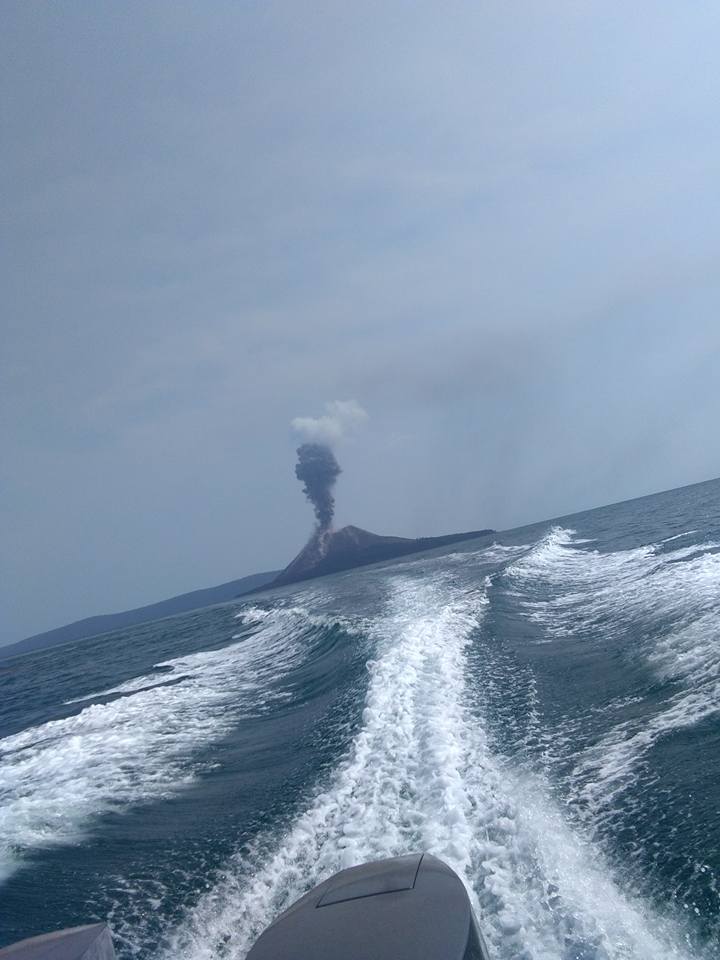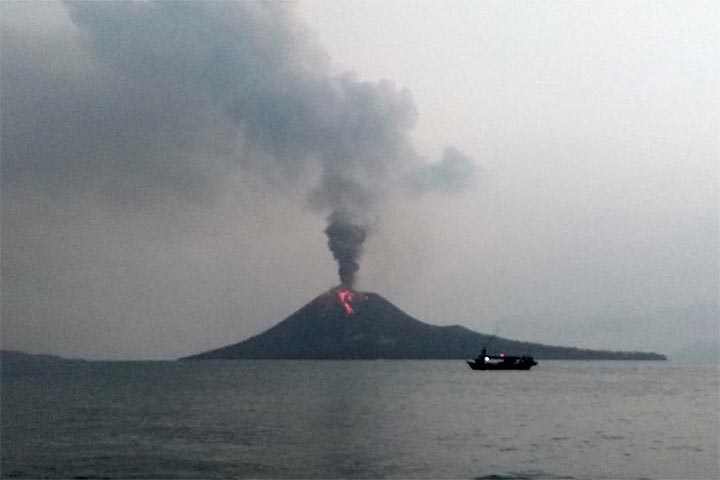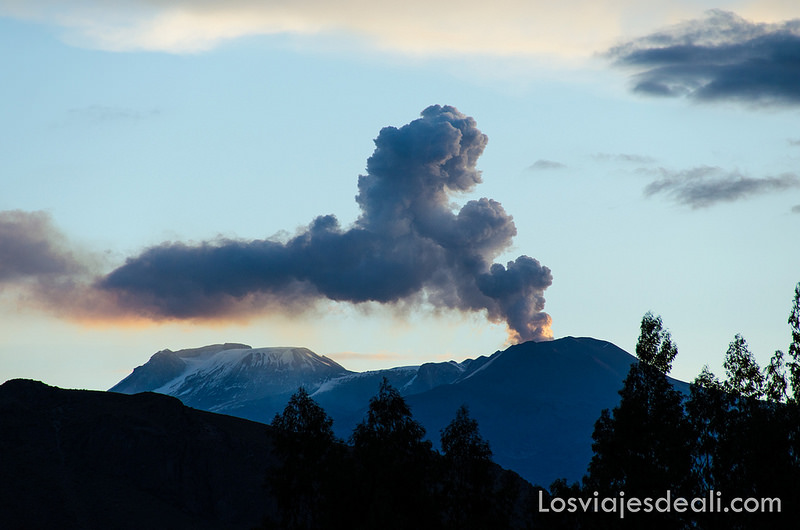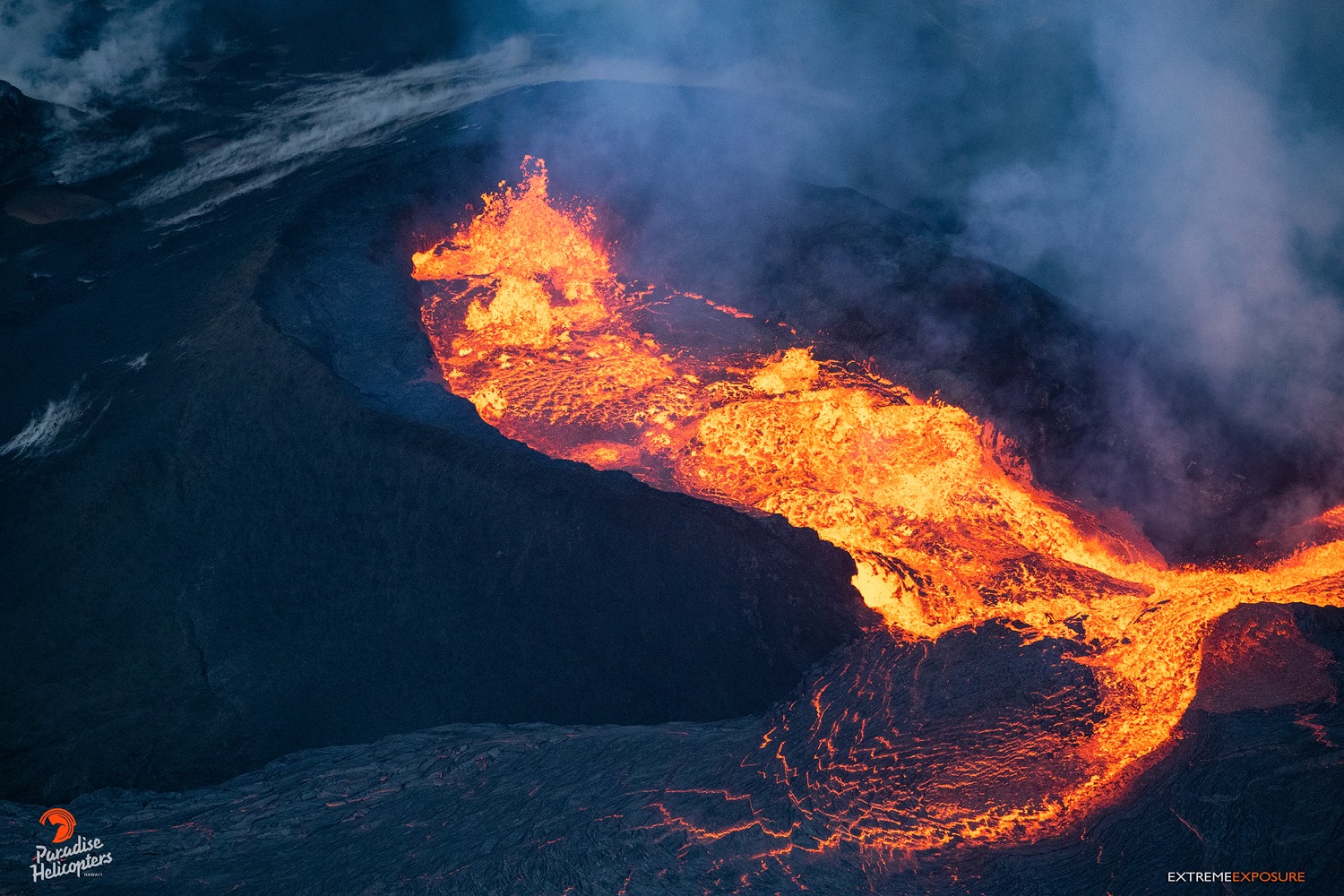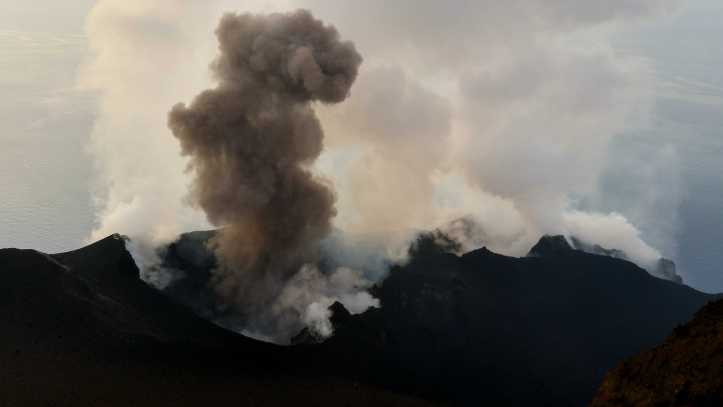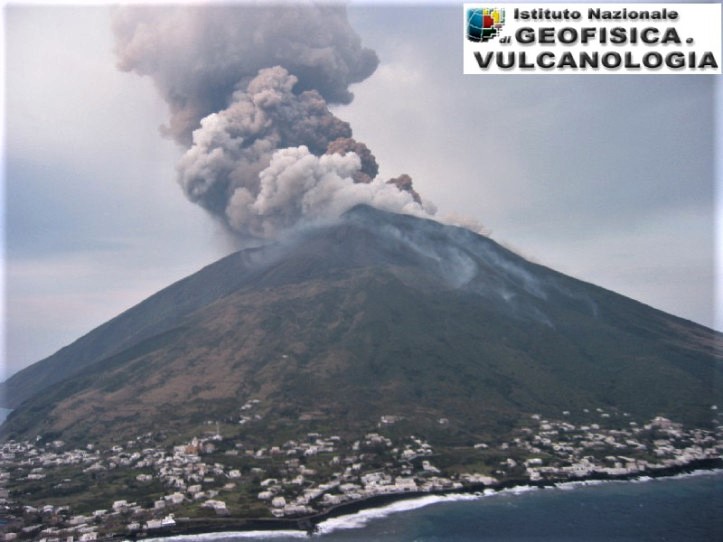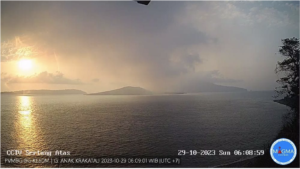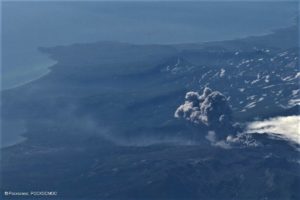July 17 , 2018.
Indonesia , Anak Krakatau :
Information on the eruption of Anak Krakatau, 16 July 2018.
There was an eruption on Anak Krakatau, Lampung, on 16 July 2018 at 16:51, with the height of the ash column observed at ± 500 m above the peak (± 305 m above sea level). of the sea). The column of ash is observed of black color with a moderate intensity inclining towards North. This eruption is recorded on seismograms with a maximum amplitude of 30 mm and a duration of ± 44 seconds.
There was an explosion noise and vibrations on the PGA antennas
Currently, Anak Krakatau is at status alert level II (Waspada) with these recommendations: The company / tourists are not allowed to approach the crater within a radius of 1km.
VOLCANO OBSERVATORY NOTICE FOR AVIATION – VONA.
Issued: July 16 , 2018 .
Volcano: Anak Krakatau (262000)
Current Aviation Colour Code: ORANGE
Previous Aviation Colour Code: orange
Source: Anak Krakatau Volcano Observatory
Notice Number: 2018KRA17
Volcano Location: S 06 deg 06 min 07 sec E 105 deg 25 min 23 sec
Area: Lampung, Indonesia
Summit Elevation: 976 FT (305 M)
Volcanic Activity Summary:
Eruption with ash clouds at 09:51 UTC (16:51 local time). The eruption lasted for 44 seconds. Eruption and ash emission is continuing.
Volcanic Cloud Height:
Best estimate of ash-cloud top is around 2576 FT (805 M) above sea level, may be higher than what can be observed clearly. Source of height data: ground observer.
Other Volcanic Cloud Information:
Ash-cloud moving to north.
Remarks:
Eruption recorded on seismogram with maximum amplitude 30 mm and maximum duration 44 second.
Source : PVMBG. Magma Indonésie .
Photo : Juhdi Black , Volcanodiscovery / Andi Rosadi.
Peru , Sabancaya :
An average of 23 EXP / day was recorded. The earthquakes associated with the rise of the magma (type Hybrids) remain very weak in number and energy.
Eruptive columns of gas and ash reached a maximum height of about 2500 m above the crater. The dispersion of these materials occurred within a radius of about 30 km, mainly to the South, Southeast, and East.
The volcanic gas flow (SO2) recorded on July 13 had a maximum value of 14859 tons / day, a value considered very large.
For the current period, there has been no deformation associated with volcanic activity.
Two thermal anomalies were recorded according to the MIROVA system, with values of 2 MW and 6 MW VRP (Radiated Volcano Power).
In general, eruptive activity maintains moderate levels. No significant changes are expected for the following days.
Source : IGP
Photo : Losviajesdeali
La Réunion , Piton de la Fournaise :
Activity Bulletin from Monday 16 July 2018 at 15:30 (local time)
The seismic activity under the summit of Piton de la Fournaise is decreasing, so have been recorded since the end of the eruption:
– 14 superficial volcano-tectonic earthquakes (<2 km deep) on July 13 (from 10 pm local time),
– 50 superficial volcano-tectonic earthquakes (<2 km deep) on July 14,
– 4 superficial volcano-tectonic earthquakes (<2 km deep) on July 15,
– 3 superficial volcano-tectonic earthquakes (<2 km deep) on July 15 (until 3 pm local time).
A slight recovery in inflation (swelling) of the volcano seems to begin. This parameter will be followed in the next few days.
Alert level: Backup
Source : OVPF
Hawai , Kilauea :
Monday, July 16, 2018, 9:31 AM HST (Monday, July 16, 2018, 19:31 UTC)
19°25’16 » N 155°17’13 » W,
Summit Elevation 4091 ft (1247 m)
Current Volcano Alert Level: WARNING
Current Aviation Color Code: ORANGE
Kīlauea Volcano Lower East Rift Zone
Fissure 8 continues to erupt lava into the perched channel leading northeastward from the vent. The channel is full but not quite up to the rim; there were no significant overflows this morning. The southern margin of the flow remained about 1 km (0.6 mi) from Isaac Hale Park this morning. Despite no visible surface connection to the fissure 8 channel, lava continues to ooze out at several points on the 6 km (3.7 mi) wide flow front into the ocean. Explosions were reported from the main ocean entry this morning with at least one being quite strong.
Fissure 22 did not appear active this morning but sounds were heard from it last night. No other fissures are active this morning.
Kīlauea Volcano Summit
Seismicity has increased as has been the pattern leading up to collapse/explosion events beneath the summit. The last event occurred at 3:26 a.m. HST July 15 with energy equivalent to a magnitude-5.2 earthquake. We expect a high rate of earthquakes (25-35 per hour) to continue until the next collapse/explosion event occurs later today.
A large explosion at the lava ocean entry that reportedly injured passengers on a lava boat tour is under investigation.
UPDATE: “At least 13 people were treated at the Hilo Medical Center after an incident on a lava tour boat early this morning,” reported the DLNR’s Division of Conservation and Resources Enforcement in an updated media release this morning. The explosion sent lava through the roof of the passenger cabin on a Lava Ocean Tours boat, DLNR said, adding that “a 20 year old woman has major leg trauma. The other passengers suffered burns and scrapes. DOCARE and other authorities are investigating this incident.”
Source : HVO
Video : Ikaika Kalama
Italy , Stromboli :
Stromboli and his explosions.
For more than a thousand years, the Stromboli volcano has erupted continuously, producing a very specific type of activity. These are intermittent explosions, with intervals that typically range from a few tens of seconds to a few minutes, which occur from craters at about 750 meters altitude near the top of the volcano. The energy of these explosions is generally modest, but still strong enough to launch into the air, up to several hundred meters of height, shreds of incandescent magma. This activity is named « Strombolian », known around the world for its unequivocal connotations. A kind of « brand » that made this volcano internationally known.
Until the beginning of the 20th century, this typical eruptive activity made Stromboli a natural « beacon » for all those who sailed in the waters of the Tyrrhenian Sea. Today, this function is passed to Strombolicchio, a little more than a rock located north of Stromboli, on which a real lighthouse has been installed to regulate the modern maritime traffic. If one thinks of the geological nature of Strombolicchio, which represents what remains of an eruptive duct going back about two hundred thousand years, it is as if the man had wanted to reactivate this ancient volcanic chimney, « re-illuminating « artificially its summit with the light of the lighthouse.
Figure 1 – Strombolian normal explosion produced by one of the craters located inside the summit crater terrace, taken in 2015 by Marco Neri.
However, the explosive activity of Stromboli knows some variations. The emission point is almost always located near the mouths inside the summit crater wall, but the energy released and the frequency of the explosions can also vary significantly. Therefore, it can be defined as « normal Strombolian activity » which is also the most common: explosions in the crater terrace and the shelling in the air of shredded lava, gas, and ashes up to a few hundred meters high, materials that fall then mainly in the same crater terrace from which they were emitted (Figure 1). This type of eruptive activity usually does not represent a real danger for the inhabitants of the island and for all the observers who climb along the paths that lead to the volcano « Pizzo sopra la Fossa », a natural scenic place about 900 meters high. meters high and overlooking the underlying crater terrace from which Strombolian activity originates.
Sometimes, however, and unpredictably, the ordinary eruptive activity of Stromboli is transformed into « larger explosions », always produced by the vents of the crater terrace but characterized by a greater energy and frequency of « normal » explosions and volumes of magma. (Figures 2 and 3). These are explosions such as those that occurred four times during the first four months of 2018 (March 7 and 18, April 24 and 27) and four times in the second half of 2017 (July 27, October 23, 1st). November 1); so that they can occur at often irregular intervals. The immediate consequence is perceptible by the different impact these events have on the environment. They, in fact, often cause fallout of volcanic bombs, lapilli and rock fragments as large enough, in the upper part of the volcano, but, compared to normal activity, at a greater distance from the vent. Therefore, the view of Pizzo sopra la Fossa and part of the paths that lead you can be affected by these fallout of volcanic materials, potentially dangerous for any observer in transit from these areas.
Figure 2 – Major explosion of April 26, 2018. Significant images taken by the infrared spectrum camera of Pizzo sopra la Fossa. The time displayed in the images is UTC (Coordinated Universal Time).
Figure 3 – Major explosion of April 26, 2018. Significant images taken by the camera of the visible spectrum of Quota 400. The time displayed in the images corresponds to UTC (Coordinated Universal Time).
Normal Strombolian activity and major explosions typically erupt magmas defined as « evolved », including slow rise towards the surface allowing them to form many crystals.
But on Stromboli also occur explosions defined as « paroxysmal ». These are decidedly violent and sudden phenomena, which often erupt from a magma considered as « primitive » and deep, which goes back so quickly towards the surface that it does not have time to crystallize and to split up partially. The paroxysmal eruptions produce volcanic bombs, incandescent lava and rock fragments in the atmosphere at heights of a few kilometers, with fallout of these materials at distances of several kilometers from the eruptive orifices (Figure 4). In some cases, such as in 1930, the eruption material fell to the ground, forming avalanches of incandescent material that rapidly traveled the volcano’s flanks to reach the sea. Their impact on the territory is therefore potentially very dangerous, since Erupting materials can trigger fires in vegetation and reach inhabited centers. Fortunately, these are events that occur with intervals of the order of tens of years. Paroxysmal explosions can occur suddenly, but usually occur during periods of intense volcanic activity. For example, as of April 5, 2003 (Figure 4), one of the most recent Stromboli paroxysmal explosions, which occurred during the eruption that began on December 28, 2002 and ended on July 18 2003.
Figure 4 – Paroxysmal explosion on April 5, 2003, taken by Sonia Calvari aboard the Civil Protection helicopter during a volcanological surveillance phase.
The most recent occurred on March 15, 2007, again during an effusive eruption. In this case, flakes of incandescent lava and fragments of rock fell to an altitude of 400 meters around the summit area of the volcano. A few blocks of lava rushed to smaller altitudes until they reached the hamlet of Ginostra, southwest of the island.
In the current state of knowledge, major and paroxysmal eruptions are not preceded by clearly recognizable precursor signs, if not a few tens of seconds before the explosive event. This delay is too short to allow those who are at the top of the volcano to take shelter.
The video shows three types of explosive events that can take place on Stromboli. The first part of the film was shot between 2013 and 2015 by Boris Behncke and resumes the so-called normal Strombolian activity. The second part of the video is taken from the recording of the surveillance cameras of the INGV and documents the major explosion that occurred on March 7, 2018. Finally, the last part of the film was made by Piergiorgio Scarlato, and resumed the paroxysmal explosion of April 5, 2003 during an eruption of several months.
Source : Pr Marco Neri ( https://ingvvulcani.wordpress.com/2018/07/16/stromboli-e-le-sue-esplosioni/ )

